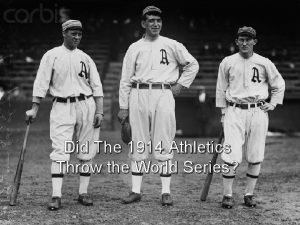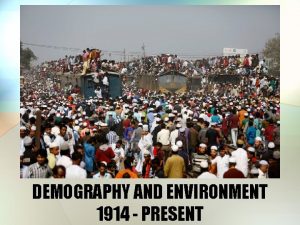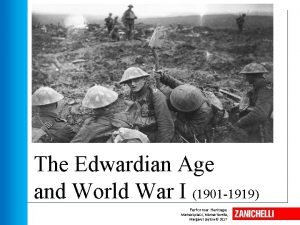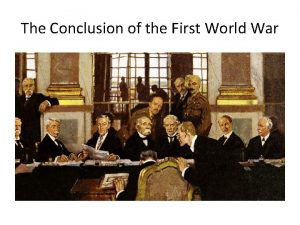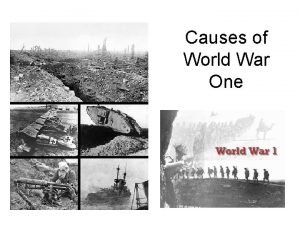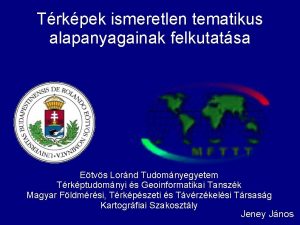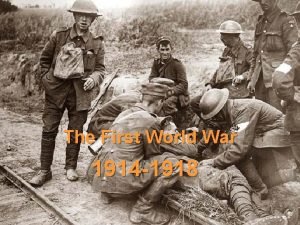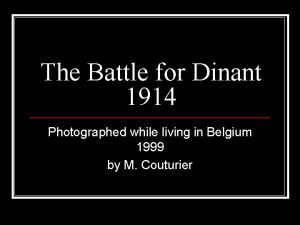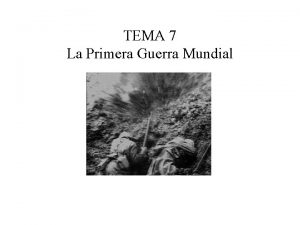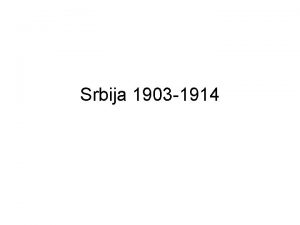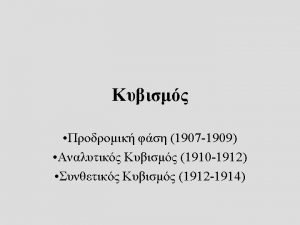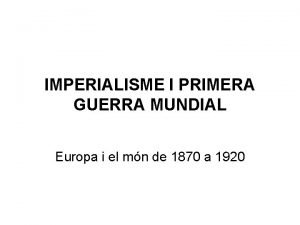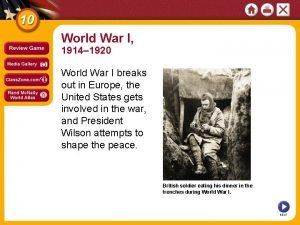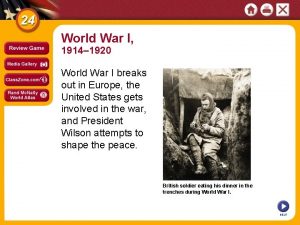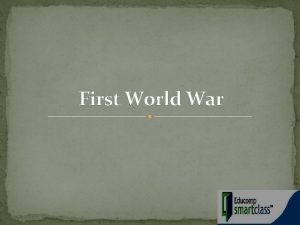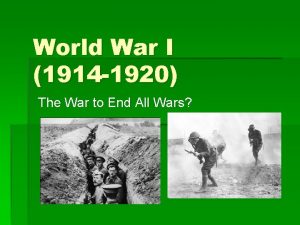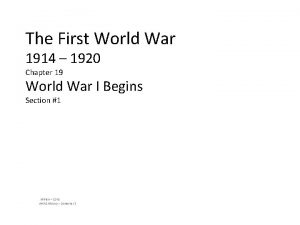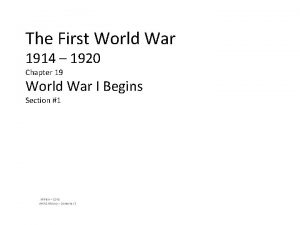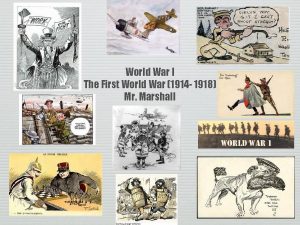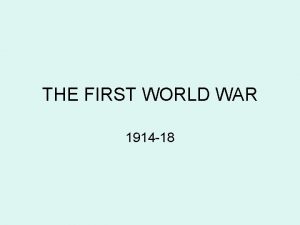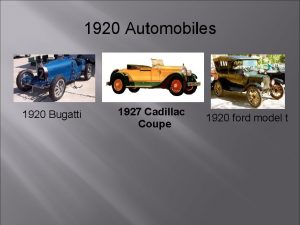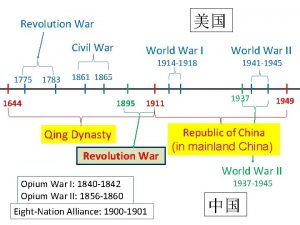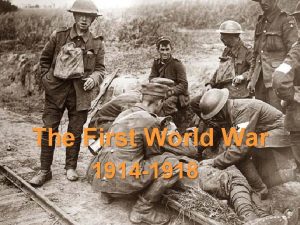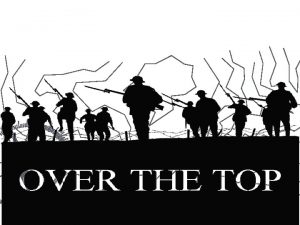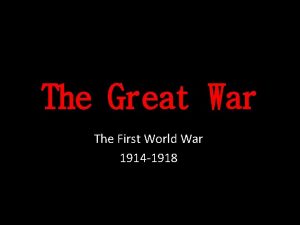The First World War 1914 1920 A World














- Slides: 14

The First World War 1914 -1920 A World In Crisis Chapter 8 Section 1

Causes of World War I http: //www. history. com/topics/world-war-i/world-wari-history/videos/causes-of-world-war-i

Causes of World War I � Nationalism �led to competition for power �struggle for greater power was most visible in the Balkans, a region of southeastern Europe populated by a great number of ethnic groups �The Austro-Hungarian Empire saw an opportunity to expand � Imperialism �Growing nationalism led nations to compete for overseas colonies �Colonies provided markets and rich natural resources. German emperor, Kaiser Wilhelm II, wanted colonies for Germany �Germany would need a stronger military.

Causes of World War I � Militarism- the policy of military preparedness and building up weapons �In 1900 Germany began to build a navy that could take on the world’s strongest sea power—Great Britain’s Royal Navy �Great Britain, France, and Russia worried about Germany’s intentions. Each country began to build its own military in order to defend itself should war break out. � Alliances � Nations formed alliances, or partnerships. � Alliances were created to maintain peace, they lead Europe directly into war. � Germany formed a military alliance with Austria-Hungary and Italy. This alliance became known as the Triple Alliance. � France and Russia formed a secret alliance with each other. � Great Britain also began to worry about Germany’s expanding navy and allied itself with France. � Britain, France, and Russia formed the Triple Entente (AHNT).

EUROPEAN ALLIANCES, 1914

ALLIANCES continued �European leaders believed that alliances created a balance of power �leaders thought that the alliance system would help decrease the chances of war. �The assassination of Archduke Franz Ferdinand exposed the flaws in this thinking. �The major European powers’ long history of national tensions, imperial rivalries, and military expansion proved too great for alliances to overcome.

War Breaks Out


War Breaks Out The Germans take Belgium � Kaiser Wilhelm II � Believed Germany needed to make this first move in order to catch Belgium and France by surprise. � Great Britain �Germany’s invasion drew a powerful nation into the conflict. GB declared war on Germany. � Major powers of Europe had to chose sides. �Germany, Austria-Hungary, and the Ottoman Empire, fighting together as the Central Powers. �Great Britain, France, and Russia, who united as the Allied Powers, or Allies. � 30 nations, including Italy, would join in what became known as The Great War. � Germans burned entire villages to the ground. Civilians caught in the fighting, including women and children, were executed.

War Breaks Out A New Kind of Warfare Germans were prepared to fight a new kind of war. The French were not. � French Soldiers � With bayonets mounted to their field rifles, they were prepared for close combat with the Germans. � French officers drew their swords and ordered their troops to charge, they were met by a hail of machine gun bullets. � The French were not prepared for Germany’s massive firepower � A well-trained German machine gun team could set up its equipment in just four seconds, and each machine gun’s firepower equaled that of 50 to 100 French rifles. � Machine guns could fire up to 600 bullets per minute and mow down thousands of troops. In early battles, some 15, 000 French soldiers died per day. � German military advisers predicted that France would be defeated in two months. � The Germans dressed in gray uniforms that worked as camouflage to help them blend into the battlefield. � French war strategy had also not changed much since the 1800 s. In Belgium, French soldiers marched row by row onto the battlefield.

The First Battle of the Marne �The German army advanced through northern France �German army was barely 25 miles from Paris. �First Battle of the Marne �French launched a daring counterattack along the Marne River east of Paris on September 7, 1914 � 2 million men fought along a battle-front that stretched 125 miles. �Five days, 250, 000 lives lost. �French rallied and pushed the Germans back some 40 miles. � The French counterattack helped the Allies by giving Russia more time to mobilize for war. � Germany had to pull some of its troops out of France to fight Russia along the Eastern Front, which

The War Reaches a Stalemate � Battle of the Marne ended in a standoff. � Both French and German soldiers dug trenches, or deep ditches, to seek protection from enemy fire and to defend their positions. � Trenches stretched for some 400 miles across western Europe. � These battle lines of the Western Front extended from Switzerland to the North Sea. Fighting in the Trenches Protected by rows of barbed wire, sandbags, and armed soldiers, trenches were very difficult to capture. Neither side could advance on the Western Front without losing thousands of men in the attack

Trench Warfare � Fighting in the trenches �soldiers lived in the trenches, surrounded by machine gun fire, flying grenades, and exploding artillery shells. �No-man’s-land became littered with bodies. �Trench warfare created a stalemate. �New weapons and technology developed New weapons �Scientists for both the Allied and Central Powers developed new weapons during World War I in an attempt to win an advantage. �German military �poisonous gas as a possible weapon to defeat the Allies. �German soldiers fired canisters of poisonous gas into Allied trenches. �A yellow-green cloud of chlorine gas miles wide enveloped

• So… Why did the United States enter this Great War in Europe? • Democracy in the world • Political Liberty • German U-Boats sank American merchant ships • How did WWI Change America? • Economic Impact • Economies devastated in Europe • Resulted in U. S. emerging as a leading world power economically • A negative aspect is inflation occurred in U. S. • Social Impact • 19 th Amendment • African American population shift to North • New and uneasy race relations • Political Impact • Led to overthrow of monarchies in Europe
 Why was the civil war the first modern war
Why was the civil war the first modern war Pstuffy bunny
Pstuffy bunny 1914 world population
1914 world population Edwardian age zanichelli
Edwardian age zanichelli Wwi conclusion
Wwi conclusion Wilhelm ii deformity
Wilhelm ii deformity What is shaded
What is shaded Európa térképe 1914-ben
Európa térképe 1914-ben Colonial empires 1914
Colonial empires 1914 Dinant 1914
Dinant 1914 Imperialism map 1914
Imperialism map 1914 Alianzas de la primera y segunda guerra mundial
Alianzas de la primera y segunda guerra mundial Srbija 1903 do 1914
Srbija 1903 do 1914 Picasso apollinaire
Picasso apollinaire Imperis colonials 1914
Imperis colonials 1914

